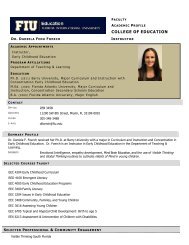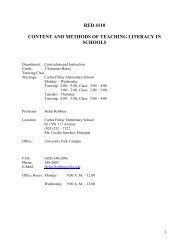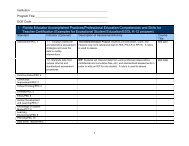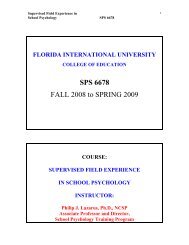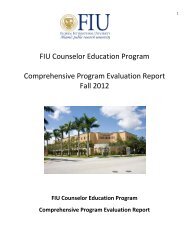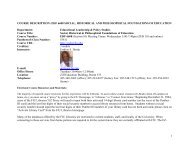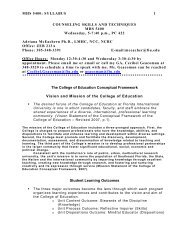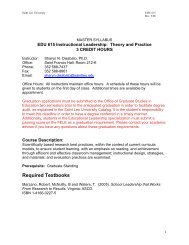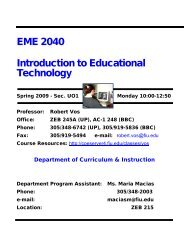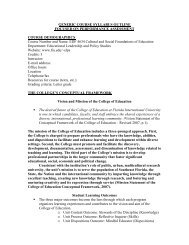2007 - College of Education - Florida International University
2007 - College of Education - Florida International University
2007 - College of Education - Florida International University
Create successful ePaper yourself
Turn your PDF publications into a flip-book with our unique Google optimized e-Paper software.
eaction to restore or maintain joint position and stability. Evidence validating the efficacy <strong>of</strong><br />
these rehabilitation exercises is scarce however, because standardizing the applied resistance is<br />
challenging. Our goal was to standardize a neuromuscular-training exercise and observe the<br />
acute effects on active JPS at the elbow. We used a vibrating dumbbell to standardize the<br />
applied resistance during elbow neuromuscular-training. Traditionally, research examining<br />
vibration has reported the occupational hazards <strong>of</strong> exposure to high loads/frequencies produced<br />
by industrial machinery on SMS function. 19-22 Strength and conditioning research has observed<br />
positive acute effects <strong>of</strong> vibration using high frequencies <strong>of</strong> whole body vibration (WBV), for<br />
periods ranging from 1 to 10 minutes. 23-28 These short bouts <strong>of</strong> WBV immediately enhance<br />
average velocity, force, and power, 23 through neuromuscular mechanisms similar to the changes<br />
observed over the first ten weeks <strong>of</strong> power-training. 29 Researchers 23-28 attribute these transient<br />
augmentations following vibration to neuromuscular mechanisms including a heightened<br />
awareness and joint control strategy with quicker rate <strong>of</strong> force development. While the precise<br />
mechanisms remain largely unknown, 22-28 researchers postulate they stem from enhanced<br />
neuromuscular efficiency. 24 Although such vibration exercises affect the components providing<br />
NMC, no research has investigated the acute effects <strong>of</strong> vibration-enhanced neuromusculartraining<br />
on SMS function. Therefore, our purpose was to examine the acute effects <strong>of</strong><br />
neuromuscular-training using handheld-vibration (HV) on SMS function as measured through<br />
active elbow JPS.<br />
Methods<br />
Research Design<br />
We used a repeated-measure, randomized, and counterbalanced 3-condition (crossover)<br />
design. The independent variables were frequency <strong>of</strong> HV at three levels (0 [control], 5, and<br />
15Hz) and time at two levels (pre- and post-test). The dependant variables were absolute<br />
(accuracy) and variable (variability) error scores measured through active elbow JPS. Subjects<br />
performed pre and post-tests 3 separate times, thereby serving as members <strong>of</strong> each group<br />
(control, 5 and 15Hz)<br />
Participants<br />
We randomly sampled <strong>of</strong> 31 healthy college-aged individuals (16 males, 15 females; 29<br />
right-handed, 2 left-handed; age= 23+3 y, mass= 76+14 kg, height= 173+8 cm). We screened<br />
participants using a health history questionnaire and excluded subjects based on prior history <strong>of</strong><br />
upper-extremity injury (within the last year), major upper-extremity surgery, or central nervous<br />
system disorder. We asked participants, 24hr before their appointment, to abstain from strenuous<br />
upper-extremity activity to help eliminate any possible fatigue or carry-over soreness. Prior to<br />
data collection, all participants read and signed an informed consent form approved by the<br />
Institutional Review Board.<br />
Instruments<br />
We collected and analyzed degrees <strong>of</strong> bilateral elbow flexion using four wired sensors<br />
from the Flock-<strong>of</strong>-Birds electromagnetic tracking system (Ascension Technology, Burlington,<br />
VT), and MotionMonitor s<strong>of</strong>tware (Innsport, Chicago, IL). This system is considered reliable 14<br />
and accurate (0.5° at 0.91m). 30 During the intervention, participants held a 2.55kg Mini-<br />
VibraFlex dumbbell (Orthometric, New York, NY).<br />
Procedures<br />
Digitizing. We digitized participants according to the <strong>International</strong> Society <strong>of</strong><br />
Biomechanics’ standardized protocol. 31 We attached sensors bilaterally to participants’ distal<br />
posterior forearm and over the deltoid tuberosity <strong>of</strong> the ulna with elastic straps and a mild spray<br />
2



